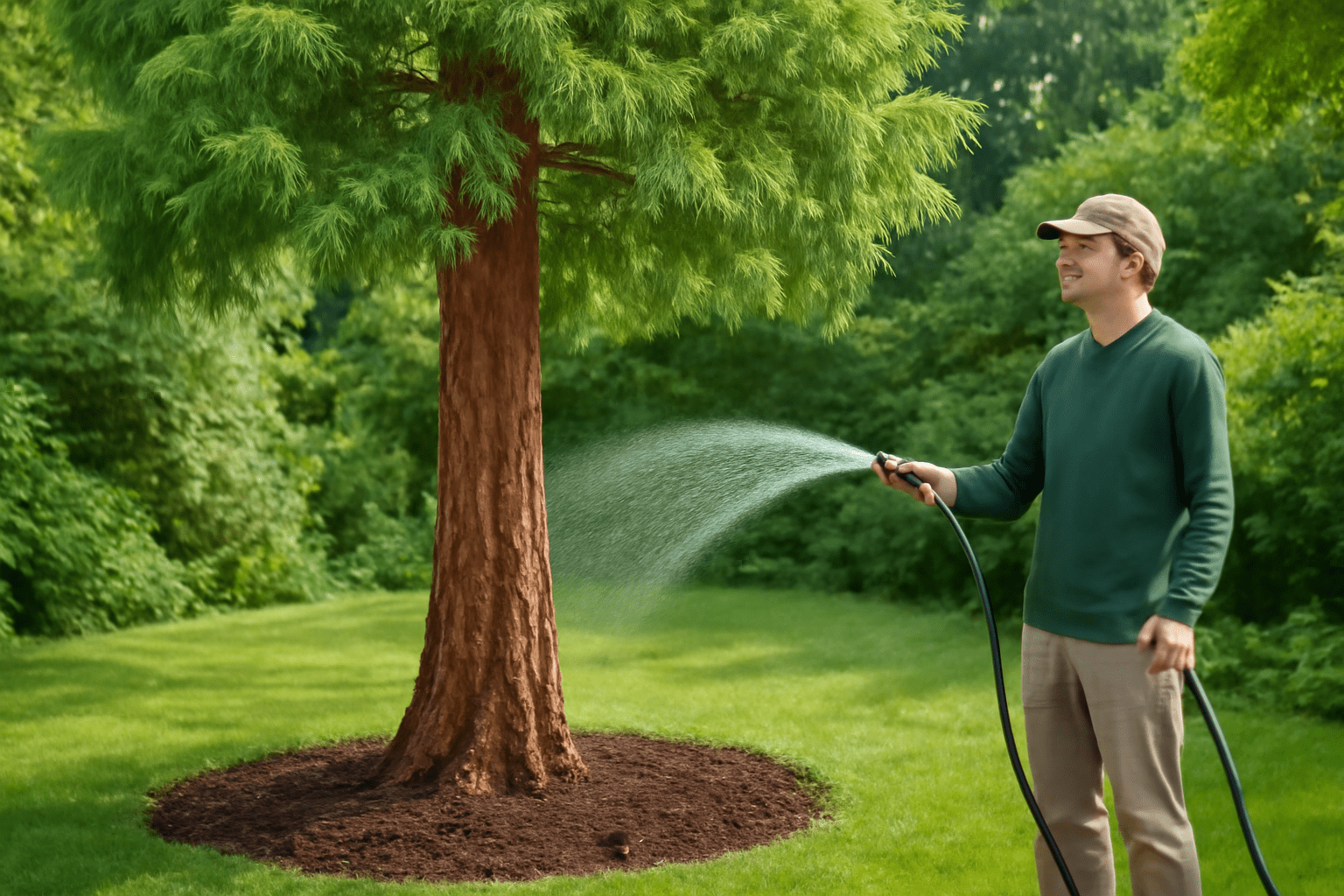
How to Care for Curly Redwood: Expert Tips for Long-Lasting Beauty and Growth
Imagine walking into a garden or forest and being greeted by the stunning, twisting beauty of a curly redwood tree. Its unique, curly bark and striking presence make it a showstopper in any landscape. But while these trees are undeniably beautiful, keeping them healthy and thriving can be a challenge for many plant lovers.
If you’re struggling with how to properly care for your curly redwood, you’re not alone. With the right knowledge and a bit of attention, these majestic trees can flourish for years, becoming the heart of your outdoor space. In this guide, we’ll walk you through expert tips and simple steps to ensure your curly redwood grows tall and strong, maintaining its beauty season after season. Whether you’re a beginner or an experienced gardener, you’ll find practical advice that can help you avoid common pitfalls and achieve lasting success with your curly redwood. Ready to give your tree the care it deserves? Let’s dive in!
Table of Contents
ToggleWhat is a Curly Redwood? 

A Curly Redwood is a unique and beautiful variation of the well-known Redwood tree, recognized for its striking, wavy grain patterns that resemble curls or waves. These distinctive features are created by the tree’s natural growth process, where the wood fibers twist in unique ways, creating a stunning visual effect.

Curly Redwood trees grow primarily in coastal areas, particularly in Northern California. They are part of the larger Redwood family, famous for their tall stature and impressive age. What makes the curly variety stand out is its high-value wood, prized for its beauty and durability. Whether you’re looking to add character to your woodworking projects or want a stunning natural feature in your home, Curly Redwood offers both elegance and strength.
This special wood is often used in fine furniture, cabinetry, and musical instruments due to its smooth texture and eye-catching patterns. Not only is Curly Redwood beautiful, but it is also incredibly strong and resistant to decay, making it perfect for long-lasting projects.
In short, Curly Redwood is more than just a tree—it’s a versatile, beautiful material that brings natural beauty and timeless charm to any space or project.
Ideal Growing Conditions for Curly Redwood 

Curly Redwood is a stunning and resilient tree, but to thrive and show off its unique beauty, it needs the right environment. Let’s dive into the ideal growing conditions to keep your Curly Redwood healthy and vibrant for years to come!
1. Sunlight: Full Sun is Key 
Curly Redwood loves sunshine! For optimal growth, plant it in a location that receives full sun—about 6-8 hours of direct sunlight daily. 

2. Soil: Well-Drained and Slightly Acidic 
Curly Redwood prefers well-draining soil that’s slightly acidic (pH of 5.5 to 6.5). Avoid heavy clay soils that retain too much water. 
3. Watering: Keep it Consistent 
Water your Curly Redwood deeply but infrequently. It likes moist soil, but it doesn’t tolerate soggy conditions. Be sure to water it when the top 1-2 inches of soil feel dry, especially during hot weather. 
4. Temperature: Moderate Climate 
Curly Redwood grows best in a moderate climate. It thrives in temperatures between 50-75°F (10-24°C). 
5. Space: Give it Room to Grow 
Curly Redwoods can grow tall, so make sure to give them plenty of space. They can reach heights of up to 100 feet (30 meters) in ideal conditions, with a spread of 25-30 feet (7.5-9 meters). Plan ahead and plant your tree at least 10-15 feet away from buildings, fences, or other trees to ensure healthy growth.
6. Humidity: It Loves Moisture 
While it doesn’t require constant rain, Curly Redwood appreciates high humidity, especially in dry climates. Consider misting the leaves or planting it near other moisture-loving plants if you’re in a dry area. 
By providing these ideal growing conditions, you’ll help your Curly Redwood grow strong and beautiful, showcasing its unique curly grain and contributing to your landscape for many years to come. Happy planting!
Planting Your Curly Redwood Tree 
Planting a curly redwood tree (also known as Sequoia sempervirens) is a rewarding experience that can transform your garden or yard into a stunning natural retreat. Follow these simple steps to ensure your curly redwood grows healthy and strong for years to come.
1. Choose the Right Location 
Curly redwoods thrive in sunny locations, so pick a spot that gets plenty of light throughout the day. They also need space to grow, as these trees can reach impressive heights. Make sure to plant your tree away from buildings, fences, or other trees that may block its growth.
2. Prepare the Soil 
Redwoods prefer slightly acidic, well-drained soil. If your soil is heavy or clay-like, mix in some compost to improve drainage and fertility. You want the soil to be loose enough for the roots to spread out easily. Check the pH of the soil, aiming for a level between 5.5 and 6.5 for optimal growth.
3. Dig the Hole 
Dig a hole that’s twice as wide and just as deep as the root ball of your curly redwood. This gives the roots enough room to establish themselves without being restricted. Gently loosen the root ball before placing it into the hole, ensuring that the top of the root ball is level with or slightly above the ground.
4. Plant with Care 
Place the tree in the hole and backfill with soil, making sure it is evenly distributed around the roots. Pat down the soil gently, but don’t compact it too much. Water the tree immediately after planting to settle the soil and remove any air pockets. This helps the roots make good contact with the soil.

5. Mulch to Retain Moisture 
Adding a layer of mulch around the base of the tree will help retain moisture, reduce weeds, and keep the soil temperature stable. Use organic mulch like wood chips or bark, and spread it about 2-3 inches thick, keeping it away from the trunk to prevent rot.
6. Water Regularly 
Curly redwoods love water, especially when they’re young. After planting, water your tree deeply, allowing the water to soak into the soil. For the first few months, water regularly (every 2-3 days) to keep the soil moist, but avoid waterlogging. Once established, water less frequently—once a week should suffice unless you’re experiencing drought conditions.
7. Monitor Growth and Health 
As your curly redwood settles into its new home, monitor its growth regularly. Look for any signs of stress, such as yellowing leaves or wilting. If you notice any issues, adjust watering habits or check for pests. This is especially important in the first couple of years while the tree is getting established.
By following these steps, you’ll give your curly redwood the best possible start, setting it on a path toward healthy, long-lasting growth.
Essential Care Tips for Healthy Growth 
Caring for Curly Redwood trees doesn’t have to be complicated! With the right knowledge and a little attention, you can enjoy a thriving, beautiful tree for years. Follow these expert tips to ensure your Curly Redwood grows strong, healthy, and gorgeous.
1. Watering – Not Too Much, Not Too Little 
Curly Redwoods love moisture, but they don’t like sitting in soggy soil. Water your tree deeply but infrequently, ensuring the soil is moist but well-drained. Aim to water once a week, adjusting based on the weather. Hot, dry spells may require more frequent watering, while rainy days might call for less.

2. Choose the Right Soil – Well-Drained is Key 
Curly Redwoods prefer rich, well-draining soil. A mix of loamy, sandy, and slightly acidic soil works best. Good drainage prevents water from pooling around the roots, which can lead to root rot. If your soil is heavy (like clay), consider adding organic matter like compost to improve drainage.
3. Sunlight – Give It Bright but Indirect Light 
These trees love light but not intense, direct sunlight for long periods. Ideally, plant your Curly Redwood in a spot with bright, indirect light. If it’s outside, a spot with partial shade during the hottest part of the day is perfect.
4. Pruning – Keep It Neat 
Pruning helps maintain the health and shape of your Curly Redwood. Trim dead or damaged branches regularly, and remove any crossing branches that might rub together. Do this during the dormant season, usually late winter or early spring, to avoid stress on the tree.
5. Fertilizing – Feed It Right 
Fertilize your Curly Redwood with a balanced, slow-release fertilizer in early spring. Look for one with a mix of nitrogen, phosphorus, and potassium to support overall health. Avoid over-fertilizing, as too many nutrients can burn the roots or encourage excessive growth at the expense of stability.
6. Pest and Disease Control – Stay Vigilant 

Curly Redwoods are generally resistant to pests and diseases, but it’s still important to keep an eye out. If you notice yellowing leaves, discolored bark, or unusual spots, inspect for pests like aphids or fungal infections. In case of an outbreak, treat the tree with natural insecticidal soap or consult a professional for more serious issues.
7. Mulching – A Layer of Protection 
Mulch around the base of your Curly Redwood to help retain moisture, regulate soil temperature, and keep weeds at bay. A 2-4 inch layer of organic mulch (like wood chips or bark) will provide all these benefits. Just be sure not to pile mulch directly against the trunk to avoid rot.
By following these essential care tips, you’ll create the perfect environment for your Curly Redwood to flourish. With a little patience and love, your tree will grow strong, healthy, and add long-lasting beauty to your space.
Common Problems and How to Solve Them 
Caring for Curly Redwood can be a rewarding experience, but like any plant, it can face some challenges. Don’t worry—most problems are easily solvable! Here’s a quick guide to the most common issues you might encounter with your Curly Redwood and how to fix them.
1. Yellowing Leaves 
Yellow leaves on your Curly Redwood usually signal a problem with watering or nutrition.
Solution:
- Watering: Ensure your plant isn’t over or underwatered. Curly Redwood prefers slightly moist soil, not soggy. If the soil feels too dry, water thoroughly. If it’s too wet, allow the soil to dry out before watering again.
- Nutrient Deficiency: Yellowing could also mean a lack of essential nutrients like nitrogen. Try feeding your plant with a balanced, water-soluble fertilizer every 4-6 weeks during the growing season to keep it healthy.

2. Brown Leaf Tips 
Brown tips on leaves can happen when the humidity is too low or the plant is stressed by temperature extremes.
Solution:
- Humidity: Curly Redwood loves humidity! Try placing it in a more humid environment or use a humidity tray (a shallow tray filled with water and pebbles) beneath the plant.
- Temperature: Keep your plant in a stable temperature range between 60-75°F (15-24°C). Avoid placing it near drafty windows or heaters, as sudden temperature changes can cause stress.
3. Wilting or Drooping Leaves 
Wilting or drooping leaves often indicate stress, either from overwatering, underwatering, or pests.
Solution:
- Check the soil moisture: If the soil is dry, give the plant a good drink. If it’s soggy, check the roots for rot. Trim away any affected roots and repot in fresh, well-draining soil.
- Pests: Inspect the plant for pests like aphids or spider mites. If you spot any, gently wipe the leaves with a damp cloth or use an insecticidal soap.
4. Stunted Growth 
Slow or stunted growth is often a sign of poor light or nutrient levels.
Solution:
- Lighting: Curly Redwood thrives in bright, indirect light. Ensure it’s placed in a spot where it can get plenty of natural light, but avoid direct sunlight, which can scorch the leaves.
- Fertilization: If growth is slow, consider increasing the frequency of your fertilizer during the growing season. A good balance of nitrogen, phosphorus, and potassium will support healthy growth.
5. Root Rot 
Root rot is a serious issue caused by overwatering or poor drainage.
Solution:
- Repotting: If your Curly Redwood’s roots are brown and mushy, it’s time to take action. Remove the plant from its pot, trim off the rotting roots, and repot it in fresh soil with good drainage. Make sure the new pot has drainage holes!
- Watering Habits: Adjust your watering routine to prevent future rot. Water only when the top inch of soil feels dry. Be sure your pot isn’t sitting in a tray of water.
6. Leaves Curling Inward 
Curly, inward curling leaves can be a sign of too much direct sunlight, low humidity, or a watering issue.
Solution:
- Light Adjustment: Move your Curly Redwood to a location with indirect light if it’s getting too much direct sun.
- Increase Humidity: Try using a humidity tray or placing a small humidifier nearby to keep the air moist.
By following these easy solutions, your Curly Redwood will be thriving and looking beautiful in no time! With just a bit of attention and care, you can avoid these common problems and ensure your plant’s long-term health. Happy gardening!
Troubleshooting and Maintaining Long-Term Health 
Taking care of your curly redwood is rewarding, but even the most experienced plant owners face occasional challenges. Here’s how to troubleshoot common issues and keep your curly redwood thriving for years to come!
1. Yellowing Leaves? 
If you notice yellowing leaves, it’s a sign that your curly redwood may be stressed. Common causes include:
- Overwatering: Too much water can suffocate the roots. Ensure the soil is well-draining and only water when the top 2 inches of soil feel dry.
- Nutrient Deficiency: Yellow leaves can also indicate a lack of essential nutrients, like nitrogen. Use a balanced fertilizer in the growing season (spring and summer) to keep the plant healthy.
2. Brown Tips? 
Brown or crispy leaf tips are another common issue. Here’s what you can do:
- Underwatering: Curly redwoods like a consistent level of moisture. If the soil dries out too often, the leaves may burn. Water thoroughly, ensuring the roots receive enough moisture.
- Low Humidity: These plants prefer a humid environment. If your home is too dry, consider placing a humidifier nearby or using a pebble tray to maintain moisture around the plant.
3. Wilting or Drooping 
Wilting can be caused by several factors, including:
- Root Rot: If the plant is drooping and the soil feels soggy, root rot might be the issue. To prevent this, make sure your pot has drainage holes and avoid letting water pool at the bottom. Trim off any rotting roots and replant in fresh, dry soil.
- Inadequate Light: Curly redwoods need bright, indirect light. If they’re placed too far from a window, they may droop due to lack of energy. Ensure they’re getting enough sunlight, but avoid harsh direct light which can burn the leaves.
4. Pests 
Curly redwoods are generally pest-resistant, but they’re not immune to occasional visitors. Look out for common pests like aphids, spider mites, and scale.
- Prevention: Keep the plant clean and regularly wipe down the leaves with a damp cloth to remove dust and potential pests. A gentle mist of water can also help.
- Treatment: If pests appear, treat the plant with an insecticidal soap or neem oil. Always test on a small leaf first to avoid damage.
5. Repotting 
Repotting your curly redwood every 1-2 years helps prevent root crowding and keeps the plant growing strong. Choose a pot that is 1-2 inches larger in diameter than the current one. Be sure to use fresh, well-draining soil to provide the best environment for healthy growth.
6. Pruning for Health 
Regular pruning keeps your curly redwood looking tidy and helps with airflow. Remove any dead or damaged leaves to prevent diseases from spreading. Be careful not to over-prune—only remove what’s necessary to maintain the plant’s shape and health.

7. Seasonal Care 

- Spring and Summer: During the warmer months, your curly redwood will be actively growing. Increase watering and give it a boost of fertilizer every 4-6 weeks to support new growth.
- Fall and Winter: In the colder months, the plant will slow down. Reduce watering and avoid fertilizing during this period to let it rest.
Pro Tips for Long-Term Health 
- Rotate Regularly: Turn your curly redwood every few weeks to ensure it grows evenly and doesn’t lean toward the light.
- Watch the Temperature: Keep your plant in a room with temperatures between 60-75°F (15-24°C). Avoid placing it near cold drafts or heat sources.
- Consistent Care: Small, consistent care is better than frequent, large changes. Stick to a regular watering and feeding schedule to keep your plant happy.
By troubleshooting issues early and following these easy maintenance tips, your curly redwood will flourish for years to come! 
Conclusion
Caring for a curly redwood may seem like a challenge at first, but with the right approach, it’s easier than you think! By ensuring your tree gets the right amount of sunlight, water, and nutrients, and by regularly tending to its needs, you can enjoy its unique beauty for years to come. Whether it’s understanding the importance of deep watering, tackling common pests, or learning the best pruning techniques, the key to success lies in consistent, thoughtful care.

Remember, a thriving curly redwood is more than just a tree; it’s a long-term investment in your outdoor space, adding charm and elegance. By applying the expert tips shared in this guide, you’ll be well on your way to growing a healthy, vibrant curly redwood that will stand out as the centerpiece of your garden or landscape.
Take pride in your curly redwood’s growth, and don’t hesitate to reach out if you encounter any challenges. After all, the journey to creating a lush, long-lasting tree is as rewarding as the end result. Happy gardening!
Frequently Asked Questions(FAQ)
How often should I water my curly redwood?
Curly redwoods need deep watering, about once a week, depending on the climate and soil. Ensure the soil remains moist but not soggy. During hot or dry periods, increase the watering frequency, but always allow the soil to dry slightly between waterings to prevent root rot.
What type of soil is best for curly redwood trees?
Curly redwoods thrive in well-draining, loamy or sandy soil with a slightly acidic to neutral pH. Adding compost or organic matter can improve soil quality and provide essential nutrients. Avoid heavy clay soils that retain too much moisture.
Can curly redwoods grow in containers or pots?
Yes, curly redwoods can grow in containers, but they need large pots to accommodate their roots. Make sure the pot has good drainage and use a well-draining soil mix. Container-grown curly redwoods will need regular watering and occasional repotting as they grow.
How much sunlight does a curly redwood tree need?
Curly redwoods prefer full sun to partial shade. While they can tolerate some shade, they grow best when they receive at least 6 hours of direct sunlight daily. If growing indoors, place them near a bright window with indirect sunlight.
What are common pests that affect curly redwood trees?
Curly redwoods can be affected by pests like aphids, scale insects, and spider mites. Regularly inspect your tree for signs of pest damage. Natural remedies such as neem oil or insecticidal soap can help control these pests without harming the tree.
How can I protect my curly redwood tree during winter?
To protect your curly redwood during winter, apply a layer of mulch around the base to insulate the roots. If temperatures drop significantly, consider wrapping the tree’s trunk with burlap to shield it from frost and cold winds. Avoid overwatering during the winter months.
When is the best time to prune my curly redwood tree?
The best time to prune curly redwoods is in late winter or early spring, before new growth begins. Focus on removing dead or damaged branches, and trim for shape if necessary. Avoid heavy pruning, as this can stress the tree.
Why is my curly redwood’s bark peeling?
Bark peeling on curly redwoods can be a natural process as the tree matures, but it may also indicate stress from environmental factors such as extreme temperatures or pests. If peeling is excessive or accompanied by other signs of stress (like yellowing leaves), check for issues like overwatering or root problems and address them promptly.







